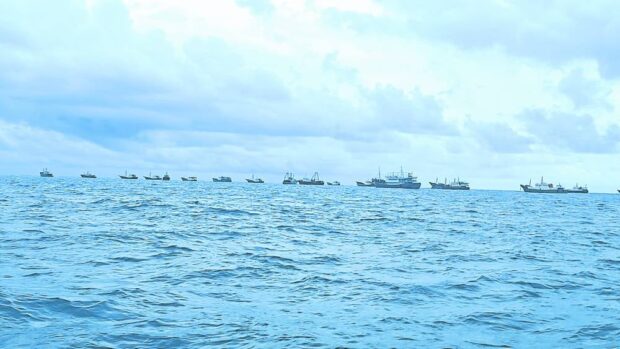
SUSTAINED PRESENCE The chief of the Western Command of the Armed Forces of the Philippines, Vice Adm. Alberto Carlos, briefed Palawan officials on Thursday about the increasing number of Chinese maritime militia vessels at Rozul (Iroquois) Reef and near Pag-asa Island. The Inquirer sawa cluster of them at Rozul as captured in this photo taken on Sept. 23. —GERALDFORD TICKE
PUERTO PRINCESA CITY—An unusual number of Chinese maritime militia (CMM) vessels have been spotted “swarming” areas in the West Philippine Sea (WPS), away from their usual haunts around Ayungin, or Second Thomas Shoal, an official of the Armed Forces of the Philippines said on Wednesday.
AFP Western Command (Wescom) chief Vice Adm. Alberto Carlos said the military had observed a bigger presence of CMM vessels at Rozul (Iroquois) Reef and near Kalayaan town’s Pag-asa Island in the last two months.
“They are no longer leaving the area, so we are preparing for the filing of a diplomatic protest. We have also taken actions to nonconfrontationally drive them away,” Carlos said during the regular meeting of the Palawan Council for Sustainable Development.
He added: “And also lately, we have monitored the sudden increase in the swarming of CMM vessels around Pag-asa Island. Last October, there were only 10 to 15; we have already monitored, as of last week, around 40 to 45.”
Carlos added that Wescom was in constant communication with the National Task Force for the West Philippine Sea (NTF WPS) for the filing of protests with China and preparing “new courses of action that will be made available to us, and authorized for us to take, so that we can address all these issues that are happening in our area.”
Pag-asa, also called Thitu Island, is located some 480 kilometers west of this city, Palawan’s provincial capital. It is the largest of the nine features occupied by the Philippines in the Spratly Islands.
On the other hand, Ayungin is an underwater feature just 195 km off mainland Palawan, over which the Philippines exercises sovereign rights and jurisdiction, despite China’s aggressive behavior in the surrounding waters.
Heightened efforts
The Filipinos maintain their presence in Ayungin through the BRP Sierra Madre, a decrepit Philippine Navy warship deliberately run aground in 1999 to serve as a military outpost.
The Philippine Coast Guard (PCG) earlier reported sighting the biggest number of Chinese vessels monitored in Ayungin Shoal—at 38—of which 28 were CMM while five were from the China Coast Guard (CCG) and five others from the People’s Liberation Army Navy.
They were seen during the latest resupply mission to BRP Sierra Madre on Nov. 10, when five CCG vessels and at least six CMM ships took part in harassing Philippine supply boats, the PCG said.The boats still made it to BRP Sierra Madre, however, and completed their task.
NTF WPS spokesperson Commodore Jay Tariela attributed the increased number of Chinese vessels to the heightened efforts of the Philippine government to reach the Ayungin outpost for the regular resupply missions.
On Thursday, the United States renewed its commitment to the Philippines in defending Manila’s sovereign rights in the South China Sea in response to Beijing’s aggressive acts in the disputed waters.
US VP renews assurance
US Vice President Kamala Harris gave the commitment during her meeting with President Marcos on the sidelines of the Asia-Pacific Economic Cooperation (Apec) Leaders’ Summit in San Francisco, United States.
Their meeting came a day after US President Joe Biden met with Chinese President Xi Jinping to discuss various issues, including sources of tension between their two countries.
In a statement, the White House said Harris and Mr. Marcos reiterated their “shared commitment to upholding international rules and norms, including in the South China Sea.”
“The Vice President reiterated [that] the United States stands shoulder-to-shoulder in defending the Philippines’ sovereign rights and jurisdiction in the South China Sea,” the White House said.
Harris reaffirmed to Mr. Marcos Washington’s defense commitment to Manila under the 1951 Mutual Defense Treaty, an agreement between the two countries to defend each other in case of an armed attack on a public vessel, troops or an airship.
In October, Biden said Washington’s defense commitment to the Philippines remained “ironclad.”
Intel-sharing
On Wednesday, Defense Secretary Gilberto Teodoro Jr. and his American counterpart Lloyd Austin III pledged to hasten the conclusion of a new framework for intelligence-sharing between the United States and the Philippines.
The pact, known as General Security of Military Information Agreement, or Gsomia, would allow real-time information-sharing on security concerns shared by the two allies.
The two leaders met on the sidelines of the Association of Southeast Asian Nations Defense Ministers’ Meeting-Plus in Jakarta, Indonesia.
“The Secretaries reaffirmed their commitment to the expeditious conclusion of [Gsomia], as well as the bilateral Philippines Security Sector Assistance Roadmap,” a joint press statement read.
Austin reaffirmed that Washington “stands shoulder-to-shoulder with the Philippines in defending its sovereign rights and jurisdiction in its exclusive economic zone.”
“The Secretaries reaffirmed that the Mutual Defense Treaty extends to both countries’ armed forces, public vessels and aircraft—including those of its Coast Guard—anywhere in the Pacific, to include the South China Sea,” the statement added.
Mr. Marcos will visit the US Indo-Pacific Command headquarters in Hawaii this week after the Apec summit in San Francisco. He will be joined by the top brass of the AFP.